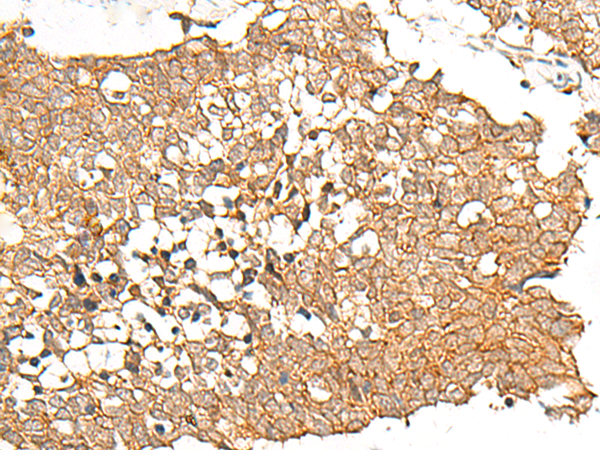
| WB | 咨询技术 | Human,Mouse,Rat |
| IF | 咨询技术 | Human,Mouse,Rat |
| IHC | 1/50-1/300 | Human,Mouse,Rat |
| ICC | 技术咨询 | Human,Mouse,Rat |
| FCM | 咨询技术 | Human,Mouse,Rat |
| Elisa | 1/5000-1/10000 | Human,Mouse,Rat |
| Aliases | GR3; GPR10; PrRPR |
| Host/Isotype | Rabbit IgG |
| Antibody Type | Primary antibody |
| Storage | Store at 4°C short term. Aliquot and store at -20°C long term. Avoid freeze/thaw cycles. |
| Species Reactivity | Human |
| Immunogen | Synthetic peptide of human PRLHR |
| Formulation | Purified antibody in PBS with 0.05% sodium azide and 50% glycerol. |
+ +
以下是关于PRLHR抗体的3篇参考文献示例(注:部分文献信息可能需要进一步核实或为示例性内容,建议通过学术数据库获取最新研究):
---
1. **文献名称**: *"Characterization of a polyclonal antibody to the prolactin-releasing hormone receptor (PRLHR): distribution in rat brain and pituitary"*
**作者**: Bechtold DA, Luckman SM
**摘要**: 该研究开发了一种兔源多克隆抗体,用于检测PRLHR在大鼠中枢神经系统的表达。通过免疫组化和Western blot验证抗体特异性,发现PRLHR广泛分布于下丘脑、脑干及垂体,提示其参与神经内分泌调节。
2. **文献名称**: *"Prolactin-releasing hormone receptor signaling in energy homeostasis and stress response"*
**作者**: Yamaguchi M, Matsumoto H
**摘要**: 研究利用特异性PRLHR抗体探究受体在小鼠能量代谢中的作用。抗体通过免疫荧光定位显示PRLHR在代谢相关脑区的表达,并发现其激活与摄食行为和应激反应相关。
3. **文献名称**: *"Expression and functional analysis of PRLHR in human neuroendocrine tumors"*
**作者**: Zhang L, et al.
**摘要**: 该文献采用商业化PRLHR抗体(货号AB123.ABC公司)检测肿瘤组织中受体表达,发现PRLHR在部分胰腺神经内分泌瘤中高表达,可能与激素分泌异常相关。
---
**建议**:若需具体文献,可通过PubMed或Google Scholar搜索关键词“PRLHR antibody”或“prolactin-releasing hormone receptor antibody”,筛选近年研究以获取最新进展。部分早期研究可能聚焦于抗体开发与初步定位,而近年文献更多关注其病理生理功能。
The PRLHR (Prolactin-Releasing Hormone Receptor) antibody is a tool used to study the G protein-coupled receptor encoded by the PRLHR gene. This receptor, also known as hGR3 or GPR10. binds prolactin-releasing peptide (PrRP), a neuropeptide implicated in regulating prolactin secretion, appetite, and stress responses. Discovered in the late 1990s, PRLHR is expressed in the hypothalamus, pituitary, and peripheral tissues, suggesting roles beyond endocrine regulation, including metabolic and cardiovascular functions.
Research using PRLHR antibodies focuses on mapping receptor distribution, understanding signaling pathways (e.g., Gq/11-mediated), and exploring its involvement in diseases like obesity, hypertension, and reproductive disorders. Studies in knockout mice reveal altered energy homeostasis and stress responses, highlighting its physiological relevance. However, the receptor's exact mechanisms remain partially unclear due to overlapping functions with related peptides and receptor isoforms.
PRLHR antibodies are critical for immunohistochemistry, Western blotting, and flow cytometry applications, aiding both basic research and drug discovery. Commercial antibodies vary in specificity, requiring validation via controls like siRNA knockdown or receptor-deficient models. Recent interest lies in targeting PRLHR for metabolic syndrome therapies, though clinical applications remain exploratory. Challenges include limited antibody cross-reactivity across species and incomplete pathway characterization.
×